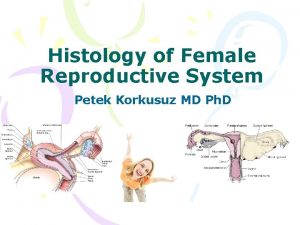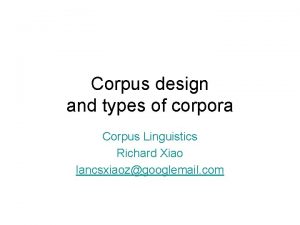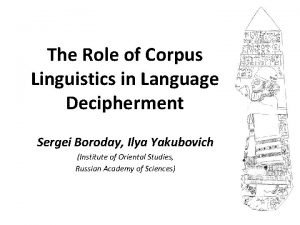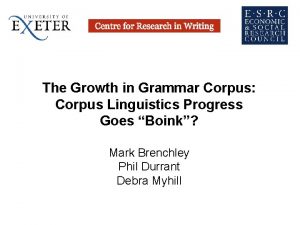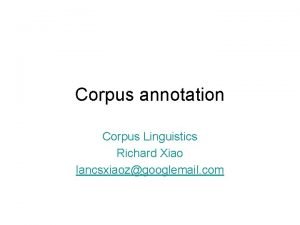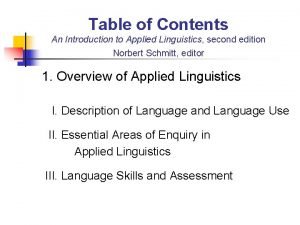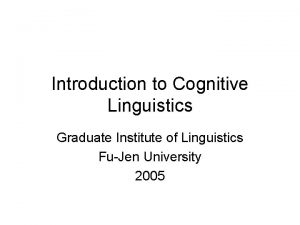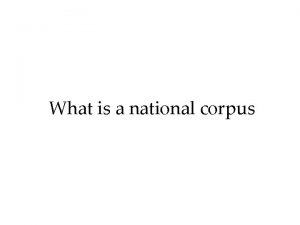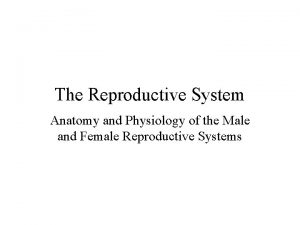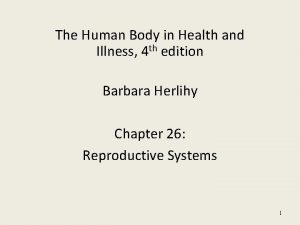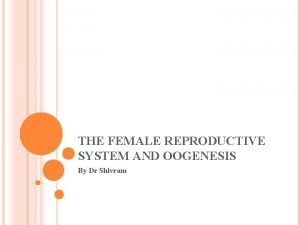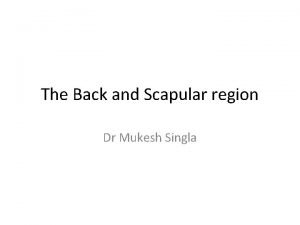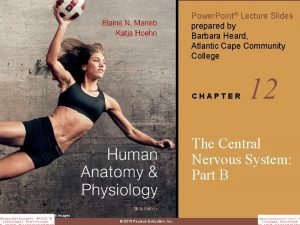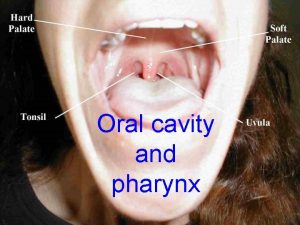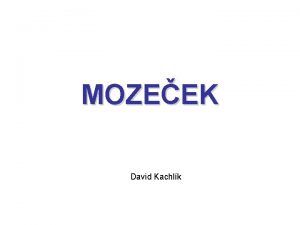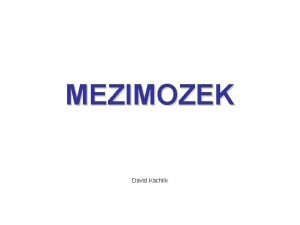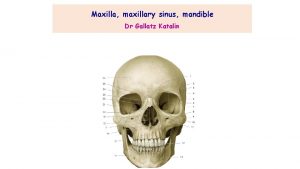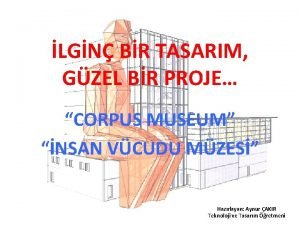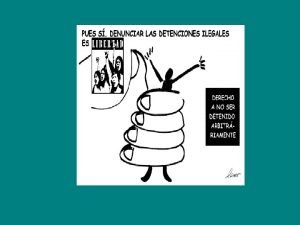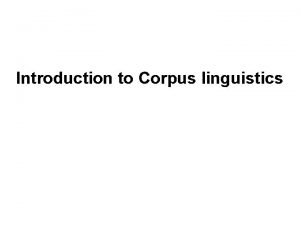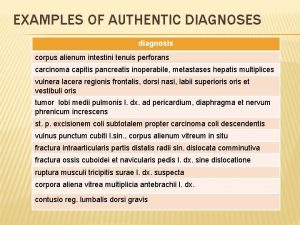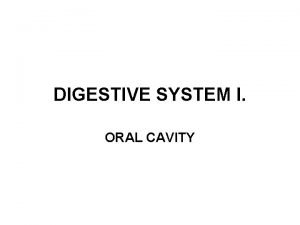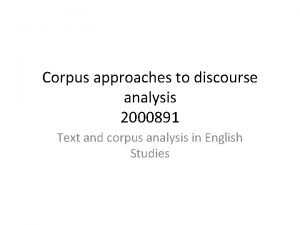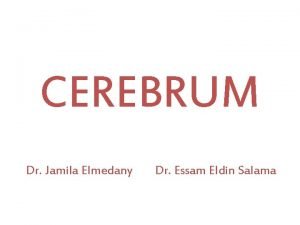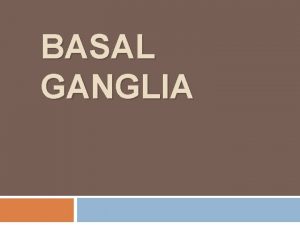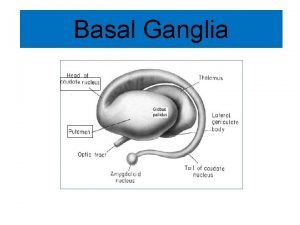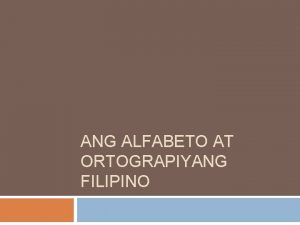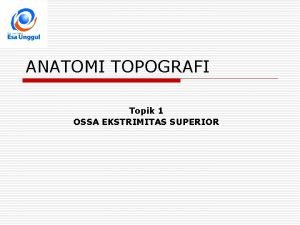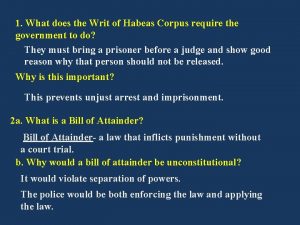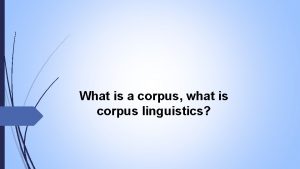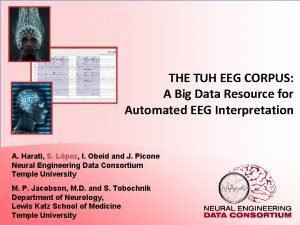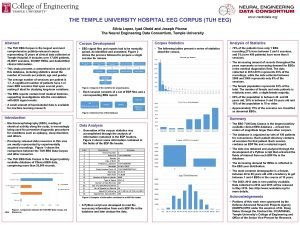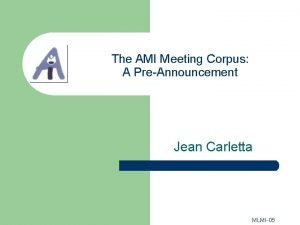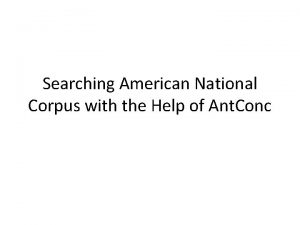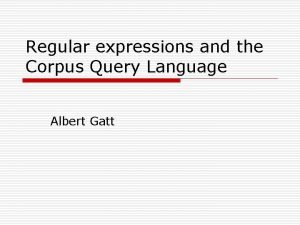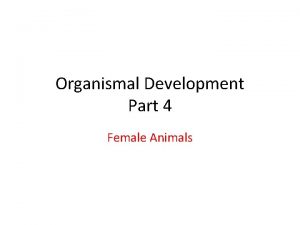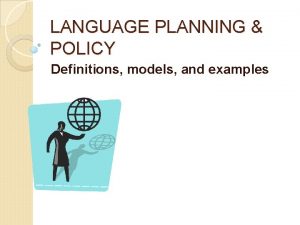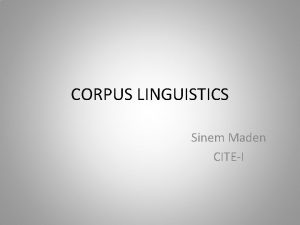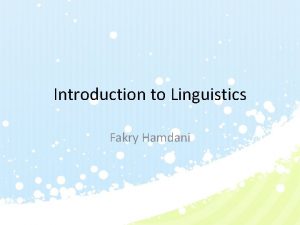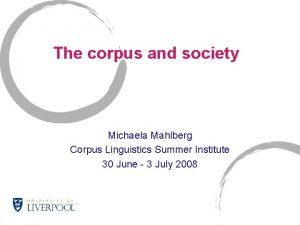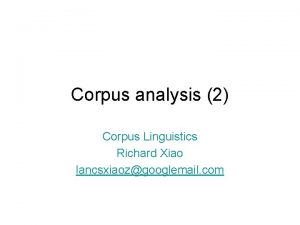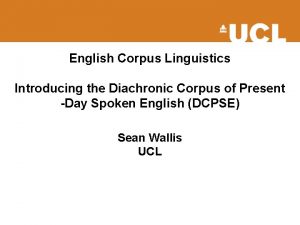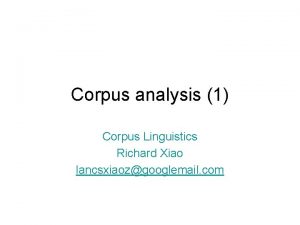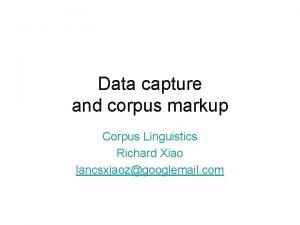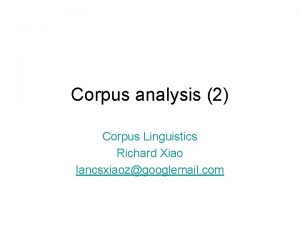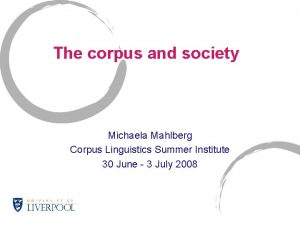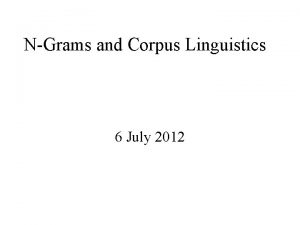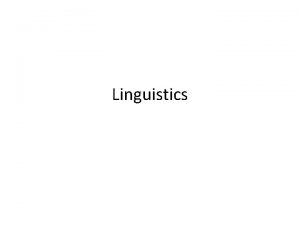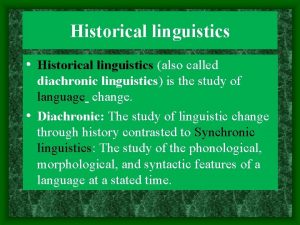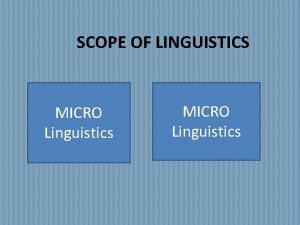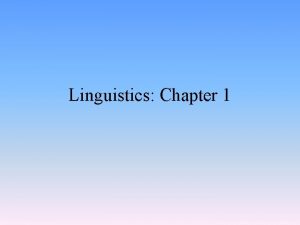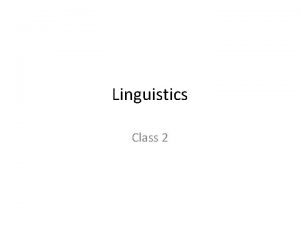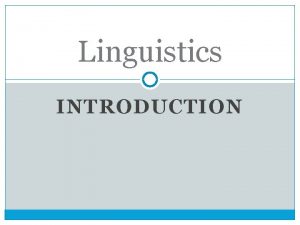Introduction to Corpus linguistics What is Corpus Linguistics


![Theoretical aspects Corpus linguistics “can be seen as a pre-application methodology. […] by “pre-application” Theoretical aspects Corpus linguistics “can be seen as a pre-application methodology. […] by “pre-application”](https://slidetodoc.com/presentation_image_h2/7aaf4195a93b3bf595650a5195d29cc3/image-3.jpg)






![What is a corpus? v [A corpus is] a subset of an ETL (Electronic What is a corpus? v [A corpus is] a subset of an ETL (Electronic](https://slidetodoc.com/presentation_image_h2/7aaf4195a93b3bf595650a5195d29cc3/image-10.jpg)







































- Slides: 49

Introduction to Corpus linguistics

What is Corpus Linguistics? A corpus is a collection of naturally-occurring language text, chosen to characterize a state of variety of a language. (J. Sinclair, 1991) Corpus Linguistics is the study of language/linguistic phenomena through the analysis of data obtained from a corpus.
![Theoretical aspects Corpus linguistics can be seen as a preapplication methodology by preapplication Theoretical aspects Corpus linguistics “can be seen as a pre-application methodology. […] by “pre-application”](https://slidetodoc.com/presentation_image_h2/7aaf4195a93b3bf595650a5195d29cc3/image-3.jpg)
Theoretical aspects Corpus linguistics “can be seen as a pre-application methodology. […] by “pre-application” we mean that, unlike other applications that start by accepting facts as given, corpus linguistics is in a position to define its own sets of rules and pieces of knowledge before they are applied. […] Corpus linguistics has, therefore, a theoretical status and because of this it is in a position to contribute specifically to other applications. (Tognini. Bonelli, Corpus linguistics at work, 2001: 1)

Historical background Ø Phase 1 – before 1950 s Franz Boas and the American Structuralism. He compiles small corpora to analyse the phonological aspects of the Inuit language, adopting an empirical approach Ø Phase 2 – after 1950 s USA – Leonard Bloomfield’s verificationism: rejects the mental approach to language in favour of an empirical one. Language studies must rely on the observation of facts. UK – the Firthian tradition: J. R. Firth – M. A. K. Halliday – J. Sinclair They draw back on Malinowski’s context of culture and context of situation. Language is a real phenomenon, which makes sense only if it is considered in its real use, i. e. as performance rather than as competence.

Historical Background Ø Reaction to Chomsky’s transformational- generative grammar (mid-20 th) Ø Dualism between competence and performance Ø Distinction between deep structures (competence) and surface structures (performance) Ø Language has to focus on competence rather than on performance Ø In short, the chomskyan linguistics - Rejects corpus linguistics since a corpus is a collection of external data (performance) - Is based on introspection and rationalism vs. empiricism.

Historical and Theoretical Issues Ø Firth/Halliday/Sinclair reject any dualism and opt for a monist view of language. Ø Focus on performance Ø To sum up some aspects in CL: - Empiricism and direct observation of real data - Performance - Form and content are indivisible -> lexico-grammar approach to language - Parole is context- and time-related. Langue is abstract and a-temporal - Use of computers to study corpora qualitatively and quantitatively.

What is a corpus v In linguistics, corpus (plural corpora) is a large and structured set of texts (now usually electronically stored and processed). A corpus may contain single texts in single language (monolingual corpus) or text data in multiple languages (multilingual corpus). Multilingual corpora that have been specially formatted for sideby-side comparison are called aligned parallel corpora. (Webster’s Online Dictionary) v A corpus is a collection of naturally-occurring language text, chosen to characterize a state or variety of a language. (Sinclair, Corpus, Concordance, Collocation, 1991: 171)

What is a corpus v A corpus can be defined as a collection of texts assumed to be representative of a given language put together so that it can be used for linguistic analysis. Usually the assumption is that the language stored in a corpus is naturally-occurring, that it is gathered according to explicit design criteria, with a specific purpose in mind, and with a claim to represent larger chunks of language selected according to a specific typology. […] in general there is consensus that a corpus deals with natural, authentic language. (Tognini-Bonelli, Corpus linguistics at work, 2001: 2)

What is a corpus v A corpus is a collection of texts, designed for some purpose, usually teaching or research. […] A corpus is not something that a speaker does or knows, but something constructed by a researcher. It is a record of performance, usually of many different users, and designed to be studied, so that we can make inferences about typical language use. Because it provides methods of observing patterns of a type which have long been sensed by literary critics, but which have not been identified empirically, the computer-assisted study of large corpora can perhaps suggest a way out of the paradoxes of dualism. (Stubbs, Words and Phrases, 2002: 239 -40)
![What is a corpus v A corpus is a subset of an ETL Electronic What is a corpus? v [A corpus is] a subset of an ETL (Electronic](https://slidetodoc.com/presentation_image_h2/7aaf4195a93b3bf595650a5195d29cc3/image-10.jpg)
What is a corpus? v [A corpus is] a subset of an ETL (Electronic Text Library) built according to explicit design criteria for a specific purpose (Atkins, Clear and Osler, “Corpus Design Criteria”, in Literary and Linguistic Computing, 7. 1, 1992: 1 -16) v a corpus is taken to be a computerised collection of authentic texts, amenable to automatic or semiautomatic processing or analysis. The texts are selected according to explicit criteria in order to capture the regularities of a language, a language variety or a sub-language. (Tognini-Bonelli, op. cit. : 55)

It follows that Texts must be collected according to specific criteria: content/genre/typology/register, etc. ; Texts must be available in machine-readable form Texts are collected in order to analyse specific linguistic phenomena

Criteria Ø Authenticity Ø Size Ø Sampling Ø Representativeness Ø Balance (Tognini-Bonelli, Corpus linguistics at work, 2001: 4764)

English Corpora Ø The Brown Corpus (1964) 1 million words, 15 genres, 500 samples/2, 000 words, written American English, texts published in the US in 1961, Brown University Ø The Lancaster-Oslo/Bergen (LOB) Corpus (1978) similar to the Brown corpus, British English, text from 1961 (compiled 1970 -1978)

English Corpora Ø The Collins Birmingham University International Language Database (COBUILD) major corpus initiative by Collins and Prof. John Sinclair at Birmingham University from 1980, 20 million-word, Collins COBUILD English Language Dictionary

English Corpora Ø The British National Corpus (BNC) 100 million-word, samples of written texts (90 m words) and spoken language (10 m words), time span 1960(fiction)-1975(non -fiction) Ø The International Corpus of English (ICE) 500 samples (300 spoken, 200 written), ~2, 000 words each, 1990 onwards, 20 national varieties of English (e. g. UK, India, Singapore, Australia, India, Jamaica) Ø The Bo. E Corpus (The Bank of English Corpus) 450 M words, full texts, open, written and spoken, mainly US and UK

Types of corpora Ø spoken vs. written Ø monolingual vs. bi/multilingual Ø parallel vs. comparable corpora (translation corpora) Ø general language purpose vs. specialised language purpose (large corpora) (small corpora) Ø diachronic vs. synchronic Ø plain text vs. annotated (tagged) text

Types of corpora Corpora Spoken Written Monolingual Bi-/Multi-lingual

Types of corpora Monolingual Language for General Purposes (LGP) Language for Special Purposes (LSP) Reference corpora Medical Corpora Economic corpora Legal corpora

Types of corpora Bi-multilingual Comparable Parallel L 1 L 2 L 3 L-N Translations L 1 to L 2 Bidirectional L 1 to L 2 to L 1 Free Translat

Types of corpora Written Corpora Synchronic (e. g. varieties of English: Br. En, USEn, Euro-English, etc. ) Diachronic (e. g. Modern English, Medieval English, etc. )

Corpus (BYU, Mark Davies)

Corpus (BYU, Mark Davies)

Uses of Corpora ü Lexicography / terminology ü Linguistics / computational linguistics Dictionaries & grammars (Collins Cobuild English Dictionary for Advanced Learners; Longman Grammar of Spoken and Written English) Critical Discourse Analysis - Study texts in social context - Analyze texts to show underlying ideological meanings and assumptions - Analyze texts to show other meanings and ways of talking could have been used…. and therefore the ideological implications of the ways that things were stated ü Literary studies ü Translation practice and theory ü Language teaching / learning ESL Teaching LSP Teaching (exemplar texts)

Lexicography / Terminology General lexicography focuses on the design, compilation, use and evaluation of general dictionaries, i. e. dictionaries that provide a description of the language in general use. Such a dictionary is usually called a general dictionary or LGP dictionary. Specialized lexicography focuses on the design, compilation, use and evaluation of specialized dictionaries, i. e. dictionaries that are devoted to a (relatively restricted) set of linguistic and factual elements of one or more specialist subject fields, e. g. legal lexicography. Such a dictionary is usually called a specialized dictionary or LSP dictionary. Terminology, in its general sense, simply refers to the usage and study of terms, that is to say words and compound words generally used in specific contexts. Terminology also refers to a more formal discipline which systematically studies of the labelling or designating of concepts particular to one or more subject fields or domains of human activity, through research and analysis of terms in context, for the purpose of documenting and promoting correct usage. This study can be limited to one language or can cover more than one language at the same time (multilingual terminology, bilingual terminology, and so forth).

Lexicography and corpora Ø Ø Ø Corpus-based lexicography started in England Corpus provides authentic uses of language Extract samples (concordance) to identify different senses Word Frequency information Help identify collocation, set phrase – Collocation : file … patent, move on, – Set phrase : night and day, black and white Ø Most English dictionaries are now corpus-based. Oxford, Collins, Longman, Cambridge, Macmillan, …

Linguistics and Corpora Ø Research on empirical linguistics Ø Study language use in various aspects – Verify linguistic theory: the explanation of definite description – Lexical studies: study near synonymous ‘little’ ‘small’ – Sociolinguistics: compare the different of languages produced from different social groups (m/f) – Cultural study: differences found in 2 comparable corpora (British/American) ….

Language Teaching and Learning Ø Corpus-based “the term corpus-based is used to refer to a methodology that avails itself of the corpus mainly to expound, test or exemplify theories and descriptions that were formulated before large corpora became available to inform language study” (Tognini-Bonelli, Corpus linguistics at work, 2001: 65)

Language Teaching and Learning Ø Corpus based : – use corpus as a resource Ø Knowledge : – Know better about English answer specific questions of certain words, phrases, structures. – Know where the problems are error analysis on a learner corpus – Know what should be taught word frequency, comparing native/learner corpora

Language Teaching and Learning Ø Corpus based : – use corpus as a resource Ø References : – create better references dictionary, grammar book, textbooks – verify certain hypotheses about languages find support examples / counter examples – use a native corpus as a reference see whether it is possible which one is more natural

Language Teaching and Learning Ø Corpus based : – use corpus as a resource Ø Syllabus design : – Native corpora => what are actually used – Learner corpora => what are the problems – Find out which aspects should be given priority – Lexical syllabus = focus on frequency of occurrence – How many words the students should know? What are they? – Knowing 90% or 95% of the words?

Language Teaching and Learning Ø Corpus-driven “In a corpus-driven approach the commitment of the linguist is to the integrity of the data as a whole, and descriptions aim to be comprehensive with respect to corpus evidence. The corpus, therefore, is seen as more than a repository of examples to back pre-existing theories or a probabilistic extension to an already well defined system. […] Examples are normally taken verbatim, in other words they are not adjusted in any way to fit the predefined categories of the analyst; recurrent patterns and frequency distributions are expected to form the basic evidence for linguistic categories; the absence of a pattern is considered potentially meaningful. ” (Tognini-Bonelli, Corpus linguistics at work, 2001: 84)

Language Teaching and Learning Ø Corpus driven – provides new paradigm of teaching/learning – students as a researcher – data driven learning – learn how to use concordance + corpora – extract generalization from data – Is it possible?

Corpus-based Translation Ø Corpora as a resource for translation Ø Parallel corpora / Translation memory – Provide examples of translation – TM software detect the most likely translation Ø Native corpora – Help editing translation to be native-like – Help understanding difficult words/concepts

Why to use a corpus? Ø Intuition alone is not enough – Is “starting” always replaceable by “beginning”? – Is it only “time” that is “immemorial”? – “think of” vs. “think about” Ø Native speaker intuition is unreliable – provides no information on frequency of occurrence – “head” => body part - Is this the most used sense? Ø Help answering questions of usage easily – More than one character is/are – Worth to do / worth doing Ø Is it sheer a synonym of pure, complete, utter and absolute?

Text vs. Corpus TEXT CORPUS Read whole Read fragmented Read horizontally Read vertically Read for content Read formal patterning Read as a unique event Read for repeated events Read as an individual act of will Read as a sample of social practice Coherent communicative event Not a coherent communicative event (Tognini-Bonelli 2001: 3)

Text vs. Corpus From time to time there is also the need for high quality information to support particular initiatives, such as the (successful) application for accreditation. Some progress has been made in recording data on the Polytechnic 's rooms and buildings, and on the teaching space requirements of individual courses. These data are analysed, along with the database on course details and students ' course and module registrations, using the methodology in DES Design Note 44. Ad hoc reports are an essential part of any system that aspires not merely to process data routinely but to permit management information to be creamed off the top.

Some basic notions of Corpus Linguistics Ø Ø Ø q q q q Concordance / Concordancer Collocation (Lexis) Colligation (Grammar) Semantic Preference (Semantics) Discourse Prosody (Pragmatics) **** Paradigmatic and Syntagmatic Dimensions Lexico-grammar approach Idiom principle vs. open-choice principle Phraseological tendency vs. terminological tendency Pattern (grammar) Extended units of meaning Cultural Keywords

Concordance / Concordancer Ø Concordance A term that signifies a list of a particular word or sequence of words in a context. The concordance is at the centre of corpus linguistics, because it gives access to many important language patterns in texts. Concordances of major works such as the Bible and Shakespeare have been available for many years. The computer has made concordances easy to compile. The computer-generated concordances can be very flexible; the context of a word can be selected on various criteria (for example counting the words on either side, or finding the sentence boundaries). Also, sets of examples can be ordered in various ways. See Sinclair 1991: Ch. 2; Mc. Enery and Wilson 1996: Ch. 1; Collier 1994; Kaye 1990; Hockey and Martin 1988. Ø Concordancer - a computer program that automatically constructs a concordance - Ant. Conc, Monoconc, Concordance, Wordsmith, Paraconc

Concordance sample of data (BNC World Edition)

Collocation Ø You shall know a word by the company it keeps (Firth 1957: 179) Ø We may use the term node to refer to an item whose collocations we are studying, and we may define a span as the number of lexical items on each side of a node that we consider relevant to that node. Items in the environment set by the span we will call collocates. (Sinclair 1966: 415) Ø Collocates are the words which occur in the neighbourhood of your search word (Scott 1999 Word. Smith Help File). Ø This a lexical relation between two or more words which have a tendency to co-occur within a few words of each other in running text. For example, PROVIDE frequently occurs with words which refer to valuable things which people need, such as help and assistance, money, food and shelter, and information. These are some of the frequent collocates of the verb. (Stubbs 2002: 24). collocates …node …collocates -------- span --------

Concordance sample of data (BNC World Edition: R-1)

Concordance sample of data (BNC World Edition: L-1)

Colligation Ø Colligation can be defined as ‘the grammatical company a word keeps and the position it prefers’: in other words, a word’s colligations describe what it typically does grammatically (Hoey 2000: 234) Ø knowledge of a collocation, if it is to be used appropriately, necessarily involves knowledge of the patterns or colligations in which that collocation can occur acceptably (Hargreaves 2000: 214).

Concordance sample of give (BNC World Edition)

Semantic Preference Semantic preference is the relation, not between individual words, but between a lemma of word-form and a set of semantically related words, and often it is not difficult to find semantic label for the set. […] [An] example is the word-form large, which often co-occurs with words for “quantities and sizes”. (Stubbs 2002: 65)

Semantic or Discourse Prosody A discourse prosody is a feature which extends over more than one unit in a linear string. […] Discourse prosodies express speaker attitude (Stubbs 2002: 65) ‘the consistent aura of meaning with which a form is imbued by its collocates’ … prosodies based on very frequent forms can bifurcate into ‘good’ and ‘bad’, using a grammatical principle like transitivity in order to do so. For example, where build up is used transitively, with a human subject, the form of the prosody is uniformly good … Where things or forces, such as cholesterol, toxins, and armaments build up intransitively, of their own account, they are uniformly bad. (Louw 1993: 171)

Concordances of build up

Semantic or Discourse Prosody

Semantic or Discourse Prosody
 Oogenesis process
Oogenesis process Ovarian stroma
Ovarian stroma Corpora design
Corpora design Corpus linguistics
Corpus linguistics Corpus linguistics
Corpus linguistics Richard xiao
Richard xiao Traditional linguistics and modern linguistics
Traditional linguistics and modern linguistics Relationship between linguistics and applied linguistics
Relationship between linguistics and applied linguistics The study of language yule
The study of language yule A concise introduction to linguistics answer key
A concise introduction to linguistics answer key An introduction to applied linguistics
An introduction to applied linguistics Lexical category
Lexical category Intro paragraph outline
Intro paragraph outline Armenian national corpus
Armenian national corpus Endometrium layer
Endometrium layer Birth canal is formed
Birth canal is formed Oogenesis diagram
Oogenesis diagram Triangle of auscultation pain
Triangle of auscultation pain Art labeling activity figure 12.11a
Art labeling activity figure 12.11a Cavitas oris
Cavitas oris Subthalamus görevi
Subthalamus görevi Tractus cortico ponto cerebellaris
Tractus cortico ponto cerebellaris Trigonum habenulare
Trigonum habenulare Age changes in mandible
Age changes in mandible Amsterdam corpus museum
Amsterdam corpus museum Prime leggi scritte
Prime leggi scritte Habeas corpus amparo
Habeas corpus amparo What is corpus?
What is corpus? Stomach anatomy and physiology ppt
Stomach anatomy and physiology ppt Z brain
Z brain Corpus luteum secretes
Corpus luteum secretes Fractura ossium nasalium
Fractura ossium nasalium Papilla ductus parotideus
Papilla ductus parotideus Heterogeneric
Heterogeneric What is corpus
What is corpus Medial surface
Medial surface Corpus striatum
Corpus striatum Corpus striatum
Corpus striatum Internal medullary lamina
Internal medullary lamina Alpabetong filipino 1987
Alpabetong filipino 1987 Ossa carpalia
Ossa carpalia The writ of habeas corpus and the grand jury both
The writ of habeas corpus and the grand jury both What is a corpus
What is a corpus Gped map
Gped map Tuh eeg
Tuh eeg Ami meeting corpus
Ami meeting corpus American national corpus
American national corpus Corpus query language
Corpus query language Corpus vagina
Corpus vagina Language planning examples
Language planning examples

